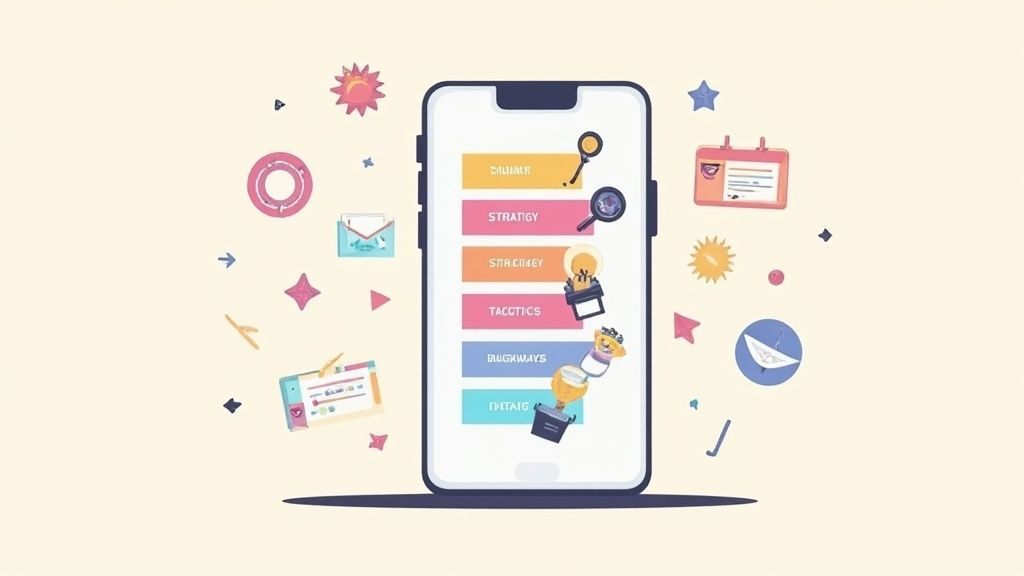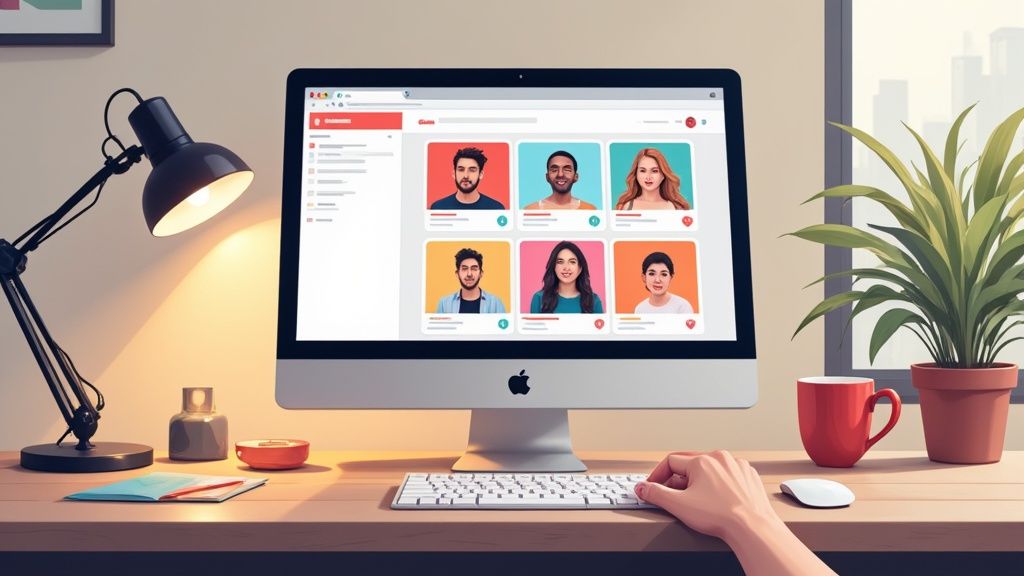How Does the Tinder Algorithm Work? Secrets to Boost Your Matches

Let's cut to the chase and get you a straight answer.
It helps to think of the Tinder algorithm less like a strict judge with a scorecard and more like a really good party host. This host pays attention. They notice when you're an engaged guest—someone who is selective with their right swipes, stays active on the app, and actually starts conversations.
The more you act like a high-quality guest, the more the algorithm introduces you to other great guests. It's that simple.
Your First Step to Getting More Matches
Ever felt like you're swiping into a black hole, with no idea who's actually seeing your profile? You’re not the only one. So many users imagine the Tinder algorithm is some mysterious, all-powerful force that randomly decides their dating fate.
In reality, it’s a sophisticated tool built for one primary goal: to create successful connections between users as efficiently as possible.
The core idea is pretty intuitive. The algorithm wants to show your profile to people who are most likely to like you back, and vice-versa. It’s a matching engine running on behavior and probability, not just a simple ranking of who’s the most attractive. Getting this distinction is the first step to better results, without feeling like you need to "game" the system.
The Pillars of Profile Visibility
At its heart, the algorithm looks for a few key signals to decide who to show you and who to show your profile to. It's not just about your photos; it's about how you actually use the app.
Here’s a breakdown of the three core pillars that the algorithm really cares about.
Core Pillars of the Tinder Algorithm
The table below summarizes the main factors Tinder uses to rank profiles and decide who sees you. Think of these as the fundamental rules of the game.
| Factor | What It Means | Why It Matters for Your Profile |
|---|---|---|
| Activity Level | How often you log in and use the app. | Active profiles are seen as more likely to chat and meet up, so the algorithm shows them to more people. |
| Swiping Behavior | How selective you are with your right swipes. | Swiping right on everyone looks like spam. Being selective signals you're a discerning user, which boosts your profile's standing. |
| Engagement Quality | Whether your matches lead to actual conversations. | Getting a match is just the start. The algorithm rewards profiles that lead to real engagement (sending messages, getting replies). |
Understanding these three areas is crucial. Nailing them tells the algorithm that you're a serious user worth promoting.
The ultimate goal for Tinder is to get people to meet up in the real world. This is exactly why proximity is such a massive factor in its logic; profiles geographically closer to you are almost always prioritized to increase the odds of a successful connection.
Behind the scenes, this whole system is built for incredible speed and reliability. The technical backbone of the Tinder algorithm is engineered to serve up match recommendations in under 50 milliseconds with a 99.9% uptime. That’s how it delivers a smooth, non-stop experience for millions of people at once.
If you're curious about the nuts and bolts, you can learn more about the technical details behind the algorithm and its architecture to appreciate just how robust it is. It's this blend of rapid processing and user-focused logic that makes the system so effective at a massive scale.
The Shift from Elo Scores to Smart Engagement
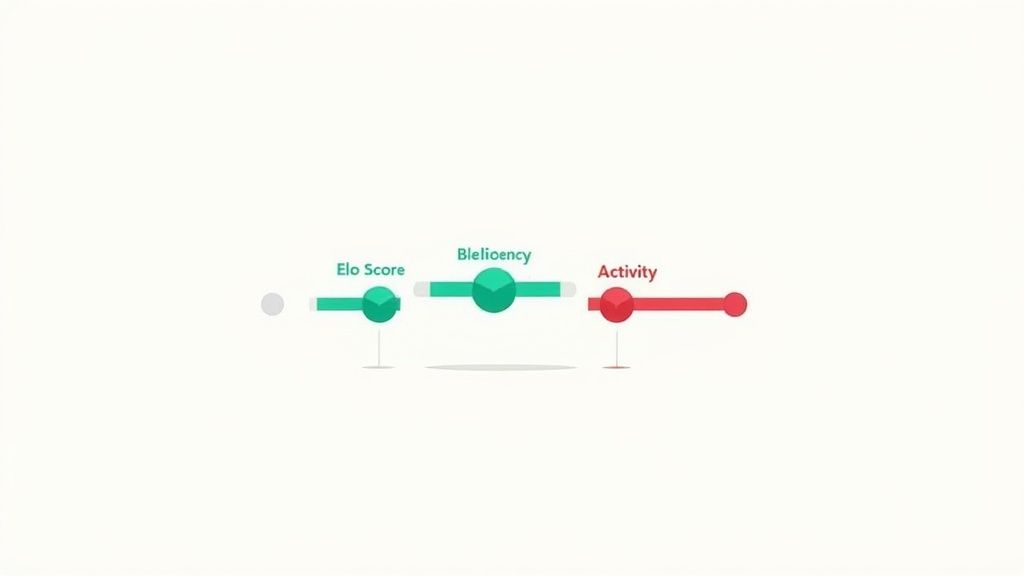
For a long time, the dating app world was obsessed with the idea of a secret "Tinder Elo score." This rumored system, which borrows its name from the rating method in competitive chess, supposedly ranked every user by how desirable they were. The concept was simple but pretty brutal.
Think of it as a never-ending "hot or not" contest. If a profile that lots of other people found attractive swiped right on you, your score would get a nice bump. If a profile with a lower score liked you, it barely made a dent. You were constantly being judged and sorted based on who liked you and, in turn, who they liked.
But in 2019, Tinder officially set the record straight: the Elo score is a thing of the past. They scrapped it because it had a huge, fundamental flaw. It was great at measuring perceived attractiveness, but it completely failed to gauge genuine compatibility or whether someone was actually going to engage.
The Problem with a Popularity Contest
The biggest weakness of the Elo system was how one-dimensional it was. It could easily tell you who was getting the most right swipes, but it couldn't tell the difference between someone genuinely looking to connect and a user who was just passively collecting matches.
This created a real headache. A user could have a sky-high Elo score because their photos were fantastic, but if they never logged in or replied to a single message, they weren't adding any value. They were like a beautiful shop window with the lights on, but the doors were permanently locked.
Tinder figured out that making successful connections meant more than just pairing up the "hottest" profiles. It required matching people who were actually active and engaged. This realization triggered a complete overhaul of their algorithm, moving the goalposts from static attractiveness to dynamic user behavior.
Becoming the Perfect Party Guest
Today's Tinder algorithm is less like a ruthless chess match and more like a social credit score—it rewards you for being a good user. Picture yourself at a party. The host wants everyone to mingle and have a great time.
Who does the host introduce to the other most interesting guests?
- Not the person awkwardly standing in the corner, ignoring everyone.
- Not the person who says "hi" to every single person without any real interest.
- Instead, the host shines a spotlight on the guest who is selective, starts thoughtful conversations, and makes others feel welcome.
This is exactly how the new system works. It’s watching how you behave to figure out if you're a "good party guest." Being an active, engaged user is now far more important for your visibility than a high "attractiveness" rating ever was.
This shift means your actions speak louder than your pictures. The algorithm rewards users who participate, start conversations, and respond thoughtfully—not just those who passively collect matches without interaction.
Understanding how to signal this positive engagement is crucial. For anyone just getting started or wanting to sharpen their approach, our getting started guide provides practical steps to set up your profile for maximum algorithmic favor right from the beginning. This ensures you start your Tinder journey as the exact kind of user the system is designed to promote.
Four Key Signals That Control Your Profile Visibility
If you want more matches, you need to start sending the right signals to Tinder's algorithm. As we've covered, your actual behavior on the app is way more important than some static "attractiveness" score. Understanding the algorithm really just means understanding which specific actions it rewards.
Think of it like this: the algorithm is constantly watching how you use the app to decide if you're a serious user worth promoting. It's looking for four critical signals that determine who sees your profile and how often. Nail these, and you'll tell Tinder you're a high-value user, which will dramatically boost your visibility.
This infographic breaks down the core action at the heart of the algorithm—the swipe—and how every choice you make sends a signal.
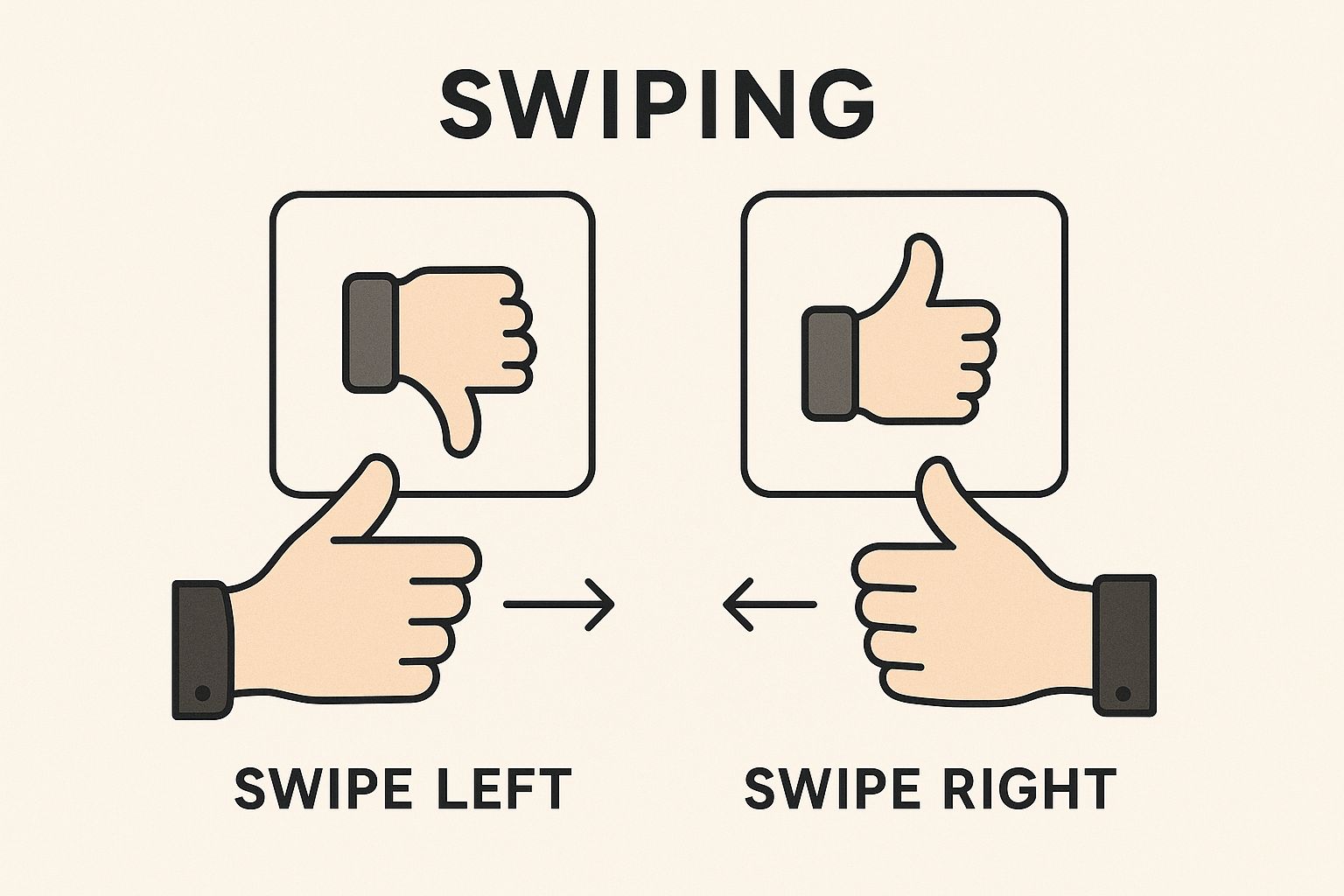
As you can see, every swipe is a data point. Each one feeds the algorithm crucial information about your preferences and just how selective you are.
Your Activity Level Matters
First things first, Tinder puts active users at the front of the line. A profile that’s rarely used is basically a dead end. Why would the app show you to other people if you're not even there to respond? Logging in daily, even just for a few minutes, sends a powerful signal that you’re an engaged member.
Tinder’s main goal is to create real-time connections. When you're online, you're much more likely to match and start chatting immediately—the exact outcome Tinder wants. Consistent activity keeps your profile fresh and at the top of the queue.
A user who was online today is way more valuable to show than someone who hasn't logged in for a week. The simplest thing you can do to get more visibility is to make using the app a daily habit.
Practice Selective Swiping
The second signal is how you swipe. It’s incredibly tempting to just swipe right on every profile to play the numbers game, but that strategy will absolutely backfire. The algorithm sees that behavior as spammy or desperate, and it can tank your profile's reach.
Instead, think of yourself as a discerning club bouncer. You don't just let everyone in; you carefully check IDs and only select the right people. By being selective with your right swipes (liking around 30-70% of the profiles you see), you signal to the algorithm that you have standards and are actually paying attention.
This thoughtful approach marks you as a quality user, and the algorithm rewards you by showing your profile to other people who are just as discerning.
Turn Matches into Conversations
Getting a match is a great start, but from the algorithm’s point of view, it's an unfinished job. The third critical signal is interaction quality. A profile with dozens of matches but zero conversations is a huge red flag. It suggests the user is a bot, isn't serious, or is just collecting matches like Pokémon cards.
Your goal should be to turn every potential match into an actual conversation.
- Send the First Message: Don't just sit there and wait. Sending a message soon after you match shows you're proactive and genuinely interested.
- Encourage a Reply: Ask open-ended questions. "Hey" is a conversation killer. Give them something interesting to respond to.
- Keep the Conversation Going: A quick back-and-forth exchange is a much stronger positive signal than a single message that gets left on read.
The algorithm rewards profiles that generate real engagement. It wants to see messages flying back and forth, as this is the clearest sign of a successful connection in the making.
Build a Deep and Complete Profile
Finally, the depth of your profile is a massive trust signal. A bare-bones profile with one blurry photo and no bio screams "low effort" or, even worse, "fake account." The algorithm favors profiles that look authentic and give other users enough information to make a real decision.
A complete, high-quality profile includes:
- Multiple Photos: Use 4-6 high-quality pictures that show different sides of your personality. Make sure you have a clear headshot, a full-body shot, and photos of you doing things you love.
- A Thoughtful Bio: A blank bio is a wasted opportunity. Write a few sentences that are witty, show who you are, and give potential matches an easy way to start a conversation.
- Linked Accounts: Connecting your Instagram or Spotify adds another layer of social proof. It helps verify you're a real person and signals to the algorithm that you're an engaged user.
Each of these elements gives the algorithm more data, confirming that you're a legitimate person who is committed to the process. You can dive deeper into optimizing every part of your profile with our guide on Tinder settings explained.
What Happens Every Time You Swipe
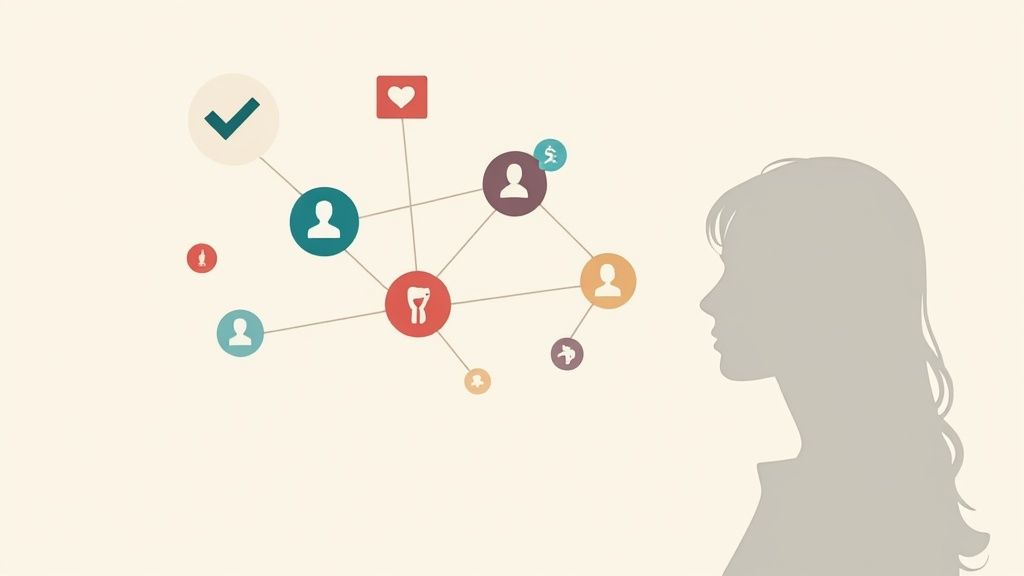
Think every swipe is just a flick of the thumb? Think again. Each time you swipe on Tinder, you’re casting a vote. You're telling the algorithm exactly what you’re looking for, what your standards are, and what kind of user you are. This directly impacts the profiles that land in front of you—and who gets to see yours.
The profiles you see are part of what's known as the "card stack," but it’s anything but a random shuffle. The algorithm is constantly sorting this deck, trying to predict who you’ll swipe right on. Your swiping habits are the main ingredient in its recipe, making every single choice a crucial piece of data.
This is why peeking behind the curtain is so important. When you understand how Tinder's algorithm reacts to every swipe, you gain real control over how your profile is ranked and who you end up matching with.
The Power of the New User Boost
When you first jump on Tinder, the app gives you a powerful, temporary leg up. It’s often called the "new user boost." For the first few days, your profile gets shown to a much larger audience than normal. Think of it as a grand opening—Tinder puts you in the spotlight to see what happens.
This boost serves two main purposes:
- To Gather Data, Fast: By putting you in front of tons of people, the algorithm quickly learns who finds you attractive. This first wave of activity on your profile sets the baseline for your score and how you'll be shown to others later on.
- To Keep You Hooked: Let's be honest, getting a bunch of matches right away feels good. It’s an exciting start that encourages new users to stick with the app.
This is exactly why your first week on Tinder often feels like the most successful. But this VIP treatment doesn't last. Once the algorithm has collected enough data, your profile's visibility settles into a more normal pattern based on how you continue to use the app.
The Dangers of Resetting Your Account
That initial boost is so tempting that many people try to recapture the magic by constantly deleting and recreating their accounts. While it sounds like a clever workaround, this is a strategy that can blow up in your face. Tinder is very much aware of this trick.
If you repeatedly reset your account, the system can flag you as a bot or someone trying to game the system. This can land you with a "shadowban," which is one of the most frustrating things that can happen on a dating app. Your account will look fine to you, but your profile is either completely hidden or shown to a tiny number of users. You’ll be swiping away, getting no matches, and have no idea why.
A shadowban is Tinder's quiet way of taking problematic profiles out of circulation without an outright ban. Trying to endlessly exploit the "new user boost" is a surefire way to get one, making it a high-risk, low-reward gamble.
Instead of trying to outsmart the system, you're far better off building a strong profile that sends the right signals to the algorithm from the start.
Why Match Rates Are So Different
One of the hottest topics in the Tinder world is the massive difference in match rates between users. This isn't just a feeling; it's a direct result of how the algorithm works and how different people use the app.
The numbers don't lie. Data shows a huge gap in match rates between men and women, and the algorithm plays a big role. On average, men see a match rate of just 2.63%, while women experience a much higher rate of around 30.7%. Age is also a factor, with users in the 18-24 bracket typically seeing more action, which reflects both user demographics and what the algorithm prioritizes. You can dive deeper into the data and learn what it means for your swiping strategy.
So, what causes this gap? It mostly comes down to swiping behavior. Men, as a group, tend to swipe right much more often. The algorithm sees this as being less selective, or lower value. Women are generally more discerning with their right swipes, which signals to the algorithm that they are more valuable. This creates a feedback loop where the picky users get shown more, reinforcing the difference in match rates.
So, Can You Pay to Win at Tinder?
Let's cut to the chase: is paying for Tinder the secret to getting more matches? It's a fair question. While Tinder’s premium features are definitely designed to get more eyes on your profile, they aren't a magic wand that overrides the algorithm.
Think of it this way: your day-to-day swiping habits build your profile's long-term reputation. Paid features are more like short, intense marketing campaigns. They can put you in front of a much larger audience, fast. But if your "advertisement"—your profile—isn't compelling, you’re just paying to show a bad ad to more people.
Let's break down what each paid feature actually does and how you can use it to your advantage.
Tinder Boost and Super Boost
A Tinder Boost is basically your personal VIP pass to the front of the swipe queue. Once you hit that button, your profile gets pushed to the top of the stack in your area for a solid 30 minutes. A Super Boost is just a longer, more powerful version of the same idea.
This doesn't change your fundamental score with the algorithm. It just lets you cut the line. You’re temporarily bypassing the normal sorting process and landing directly in front of way more users than you normally would. It's a killer way to get a quick surge of views, especially if you time it right, like during peak hours on a Sunday evening.
Here’s the deal: A Boost works best when your profile is already firing on all cylinders. If your photos are great and your bio is sharp, all that extra exposure will translate directly into more matches. If your profile is weak, you're not going to see the results you want.
The Strategic Value of a Super Like
A Super Like is a more focused, almost tactical tool. Instead of shouting your profile from the rooftops to everyone, it sends a direct, unmissable signal to one specific person. When you Super Like someone, your profile shows up in their queue with a bright blue border, guaranteeing they'll see you. That's a huge advantage, since a regular right swipe offers no such guarantee.
The Super Like really does two things at once:
- It gets you seen: It cuts through all the other profiles and ensures you're noticed by someone you’re genuinely interested in.
- It shows strong interest: That little blue star says you used one of your rare Super Likes on them, which can be pretty flattering and make your profile stand out.
It’s not going to force them to match with you, of course. But it’s a great way to grab the attention of someone you think you’d really vibe with.
Tinder Premium Features and Algorithmic Impact
So, what about the big subscriptions like Tinder Plus, Gold, and Platinum? They bundle these features together and add a few more perks. But a lot of people get confused about how they actually interact with the algorithm.
This table breaks down how each paid feature really stacks up in the eyes of the algorithm.
| Feature | Primary Function | How It Affects the Algorithm |
|---|---|---|
| Unlimited Likes | Removes the daily cap on right swipes. | No direct algorithmic boost. Can actually hurt your score if you swipe right on everyone, as this signals desperate or bot-like behavior. |
| See Who Likes You | Reveals a grid of users who have already swiped right on you. | No direct algorithmic boost. It’s a shortcut to instant matches, which can lead to positive engagement signals if you actually start conversations. |
| Priority Likes (Platinum) | Your likes are seen before non-subscribers' likes by users you swipe on. | A direct, sustained advantage. This is the only feature that consistently puts you ahead in others' queues, acting like a slow, continuous Boost. |
Ultimately, paying for Tinder gives you tools to be more efficient and get more exposure. Out of all of them, the Priority Likes from a Tinder Platinum subscription offer the most significant and lasting algorithmic advantage by keeping you near the top of other people's swipe decks.
But the core principle never changes: these features just amplify what’s already there. Your success still boils down to having a great profile and using the app in a smart, engaging way.
Alright, let's turn that AI-generated script into something a real person would actually write and follow.
Here’s the rewrite:
Your 7-Day Action Plan to Master the Algorithm
Knowing how the Tinder algorithm works is one thing. Actually using that knowledge to get more matches? That's a whole different game.
Let's cut through the theory and get straight to what works. This simple, 7-day action plan is your roadmap to a complete profile and strategy reset. Each day has one focused task designed to send all the right signals to the algorithm.
Think of it as a boot camp for your dating profile. Forget trying to find weird cheats or hacks. The goal here is to become the exact kind of user the algorithm is built to reward: someone who's active, engaging, and worth showing to other top-tier profiles.
Your Daily Reset Checklist
This isn't about sinking hours into the app. It's about making small, smart moves each day that add up. Let's get started.
Day 1: Curate Your Photos. First things first, your photos are 90% of the battle. Ditch the blurry group shots and the bathroom selfies immediately. You need 4-6 high-quality images that tell a story. Show your hobbies, a cool trip you took, or just a shot of you laughing. It signals you're a real person who puts in a little effort.
Day 2: Craft a Compelling Bio. A blank bio is the biggest red flag on Tinder. It screams "I'm not serious about this." Write a short, punchy bio that shows off your personality. The goal is to give someone an easy way to start a conversation, so ask a question or drop a fun fact about yourself.
Day 3: Practice Mindful Swiping. Today, your only job is to be picky. Seriously. No more swiping right on every single profile hoping something sticks. Only swipe right on people you are genuinely interested in meeting. This one simple change tells the algorithm you have standards, which is a massive signal for boosting your profile's visibility.
Key Insight: Getting the algorithm on your side is less about technical tricks and more about how you present yourself. The better you look and the more engaging you are, the better your results. For some real-world advice, this guide on how to look more attractive has some great, actionable tips that will directly improve your photos and overall vibe.
- Day 4: Develop Engaging Openers. "Hey" is a conversation killer. It's time to put it to rest. Come up with three interesting, open-ended questions you can use as your go-to openers. A great first message shows you're actually trying to connect, not just racking up matches you'll never talk to.
The Final Three Days of Your Reset
You've laid the groundwork. Now, the next few days are all about locking in these good habits and building momentum.
Day 5: Focus on Responsiveness. Pop into the app a few times today. When a match or a message comes in, try to reply within a couple of hours. Fast responses are a huge green flag for the algorithm—it shows you’re an active and engaged user, and it will reward you for it.
Day 6: Review and Refine. Take a step back and look at your profile with fresh eyes. Is one of your photos getting zero love? Could your bio be a little more intriguing? Don't be afraid to make small tweaks. Sometimes a tiny change makes all the difference.
Day 7: Plan Your Activity. The grind doesn't stop here. Make a commitment to log in every day, even if it's just for five minutes. Keep swiping selectively and having real conversations. This week was your reset, and if you want to turn these new habits into long-term success, check out our guide on maximizing your match potential.
Diving Into Your Top Tinder Algorithm Questions
Let's cut through the noise and tackle some of the biggest questions people have about the Tinder algorithm. I see these pop up all the time, so here are some straight answers to help you swipe smarter, not just harder.
Does Tinder Really Penalize You for Swiping Right on Everyone?
Yes, a hundred percent. Mindlessly swiping right on every single profile is one of the worst things you can do for your account.
Think about it from Tinder’s point of view. If you like everyone, you look like a spam bot or someone who has zero standards. This tells the algorithm that you aren't a serious, selective user. As a result, it’ll likely push your profile down in the queue, showing you to fewer people and giving priority to users who are more thoughtful with their swipes. The name of the game is selective swiping—it signals you're a high-value user.
How Long Does a Tinder Shadowban Actually Last?
Ah, the dreaded shadowban. While Tinder won't ever send you a notification about it, a shadowban is essentially when your profile becomes a ghost, totally invisible to other users. The tricky part? There's no official timeline. A shadowban could last a couple of weeks, or it could be permanent.
It's usually triggered by breaking Tinder's rules or by constantly resetting your account. Because it's an unofficial penalty, just waiting for it to go away is rarely a good strategy. The most effective fix is often the most drastic: delete the account completely and start over with a fresh one, making sure you don't repeat the same mistakes.
Key Takeaway: Treat an account reset as a last resort, not a quick fix. A proper reset requires a new phone number or login method and is really only for extreme cases like a shadowban or after you've totally revamped your profile. If you keep resetting, Tinder's system will catch on and your score will suffer.
So, Is It a Good Idea to Restart My Tinder Account?
It can be, but only under the right circumstances. If you've seriously upgraded your photos and bio, or if you have good reason to believe you're shadowbanned, then a reset can give you that "new user boost" and a clean slate.
But if you're just doing it to try and cheat the system, I'd advise against it. Tinder is smarter than you think; it can easily track your device and other data. Frequent resets will get you flagged. It's much better to focus on improving the signals your current profile sends out—staying active, being selective, and actually engaging with your matches—than to constantly be hitting the reset button.
Will the Algorithm Show Me People Who Already Swiped Left?
In general, no. Once someone swipes left on you, they're pretty much out of your deck for good. The algorithm is designed to create matches, so showing you someone who's already passed on your profile would just be a waste of everyone's time. While a random glitch might happen here or there, the system is built to keep things moving forward efficiently.
Ready to stop guessing and start matching? Auto-Swiper automates your swiping on Tinder and other dating apps based on your smart preferences, saving you hours while boosting your profile's activity signals. Learn more at https://auto-swiper.ch.
